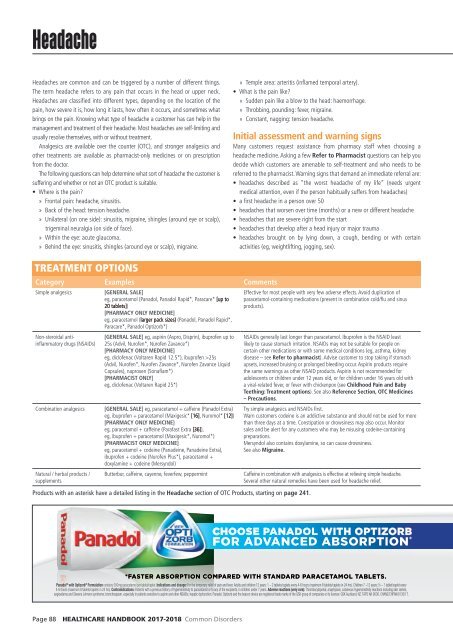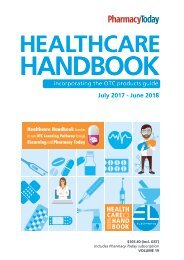2017 HCHB_digital
You also want an ePaper? Increase the reach of your titles
YUMPU automatically turns print PDFs into web optimized ePapers that Google loves.
Headache<br />
Headaches are common and can be triggered by a number of different things.<br />
The term headache refers to any pain that occurs in the head or upper neck.<br />
Headaches are classified into different types, depending on the location of the<br />
pain, how severe it is, how long it lasts, how often it occurs, and sometimes what<br />
brings on the pain. Knowing what type of headache a customer has can help in the<br />
management and treatment of their headache. Most headaches are self-limiting and<br />
usually resolve themselves, with or without treatment.<br />
Analgesics are available over the counter (OTC), and stronger analgesics and<br />
other treatments are available as pharmacist-only medicines or on prescription<br />
from the doctor.<br />
The following questions can help determine what sort of headache the customer is<br />
suffering and whether or not an OTC product is suitable.<br />
• Where is the pain?<br />
»»<br />
Frontal pain: headache, sinusitis.<br />
»»<br />
Back of the head: tension headache.<br />
»»<br />
Unilateral (on one side): sinusitis, migraine, shingles (around eye or scalp),<br />
trigeminal neuralgia (on side of face).<br />
»»<br />
Within the eye: acute glaucoma.<br />
»»<br />
Behind the eye: sinusitis, shingles (around eye or scalp), migraine.<br />
»»<br />
Temple area: arteritis (inflamed temporal artery).<br />
• What is the pain like?<br />
»»<br />
Sudden pain like a blow to the head: haemorrhage.<br />
»»<br />
Throbbing, pounding: fever, migraine.<br />
»»<br />
Constant, nagging: tension headache.<br />
Initial assessment and warning signs<br />
Many customers request assistance from pharmacy staff when choosing a<br />
headache medicine. Asking a few Refer to Pharmacist questions can help you<br />
decide which customers are amenable to self-treatment and who needs to be<br />
referred to the pharmacist. Warning signs that demand an immediate referral are:<br />
• headaches described as “the worst headache of my life” (needs urgent<br />
medical attention, even if the person habitually suffers from headaches)<br />
• a first headache in a person over 50<br />
• headaches that worsen over time (months) or a new or different headache<br />
• headaches that are severe right from the start<br />
• headaches that develop after a head injury or major trauma<br />
• headaches brought on by lying down, a cough, bending or with certain<br />
activities (eg, weightlifting, jogging, sex).<br />
TREATMENT OPTIONS<br />
Category Examples Comments<br />
Simple analgesics<br />
Non-steroidal antiinflammatory<br />
drugs (NSAIDs)<br />
Combination analgesics<br />
Natural / herbal products /<br />
supplements<br />
[GENERAL SALE]<br />
eg, paracetamol (Panadol, Panadol Rapid*, Paracare* [up to<br />
20 tablets])<br />
[PHARMACY ONLY MEDICINE]<br />
eg, paracetamol (larger pack sizes) (Panadol, Panadol Rapid*,<br />
Paracare*, Panadol Optizorb*)<br />
[GENERAL SALE] eg, aspirin (Aspro, Disprin), ibuprofen up to<br />
25s (Advil, Nurofen*, Nurofen Zavance*)<br />
[PHARMACY ONLY MEDICINE]<br />
eg, diclofenac (Voltaren Rapid 12.5*), ibuprofen >25s<br />
(Advil, Nurofen*, Nurofen Zavance*, Nurofen Zavance Liquid<br />
Capsules), naproxen (Sonaflam*)<br />
[PHARMACIST ONLY]<br />
eg, diclofenac (Voltaren Rapid 25*)<br />
[GENERAL SALE] eg, paracetamol + caffeine (Panadol Extra)<br />
eg, ibuprofen + paracetamol (Maxigesic* [16], Nuromol* [12])<br />
[PHARMACY ONLY MEDICINE]<br />
eg, paracetamol + caffeine (Parafast Extra [36]),<br />
eg, ibuprofen + paracetamol (Maxigesic*, Nuromol*)<br />
[PHARMACIST ONLY MEDICINE]<br />
eg, paracetamol + codeine (Panadeine, Panadeine Extra),<br />
ibuprofen + codeine (Nurofen Plus*), paracetamol +<br />
doxylamine + codeine (Mersyndol)<br />
Butterbur, caffeine, cayenne, feverfew, peppermint<br />
Products with an asterisk have a detailed listing in the Headache section of OTC Products, starting on page 241.<br />
Effective for most people with very few adverse effects. Avoid duplication of<br />
paracetamol-containing medications (present in combination cold/flu and sinus<br />
products).<br />
NSAIDs generally last longer than paracetamol. Ibuprofen is the NSAID least<br />
likely to cause stomach irritation. NSAIDs may not be suitable for people on<br />
certain other medications or with some medical conditions (eg, asthma, kidney<br />
disease – see Refer to pharmacist). Advise customer to stop taking if stomach<br />
upsets, increased bruising or prolonged bleeding occur. Aspirin products require<br />
the same warnings as other NSAID products. Aspirin is not recommended for<br />
adolescents or children under 12 years old, or for children under 16 years old with<br />
a viral-related fever, or fever with chickenpox (see Childhood Pain and Baby<br />
Teething: Treatment options). See also Reference Section, OTC Medicines<br />
– Precautions.<br />
Try simple analgesics and NSAIDs first.<br />
Warn customers codeine is an addictive substance and should not be used for more<br />
than three days at a time. Constipation or drowsiness may also occur. Monitor<br />
sales and be alert for any customers who may be misusing codeine-containing<br />
preparations.<br />
Mersyndol also contains doxylamine, so can cause drowsiness.<br />
See also Migraine.<br />
Caffeine in combination with analgesics is effective at relieving simple headache.<br />
Several other natural remedies have been used for headache relief.<br />
CHOOSE PANADOL WITH OPTIZORB<br />
FOR ADVANCED ABSORPTION *<br />
*FASTER ABSORPTION COMPARED WITH STANDARD PARACETAMOL TABLETS.<br />
Panadol ® with Optizorb ® Formulation contains 500mg paracetamol per tablet/caplet. Indications and dosage: For the temporary relief of pain and fever. Adults and children 12 years: 1 – 2 tablets/caplets every 4-6 hours (maximum 8 tablets/caplets in 24 hrs). Children 7 –12 years: ½ – 1 tablet/caplet every<br />
4-6 hours (maximum 8 tablets/caplets in 24 hrs). Contraindications: Patients with a previous history of hypersensitivity to paracetamol or to any of the excipients; in children under 7 years. Adverse reactions (very rare): Thrombocytopenia; anaphylaxis, cutaneous hypersensitivity reactions including skin rashes,<br />
angioedema and Stevens Johnson syndrome; bronchospasm, especially in patients sensitive to aspirin and other NSAIDs; hepatic dysfunction. Panadol, Optizorb and the beacon device are registered trade marks of the GSK group of companies or its licensor. GSK Auckland, NZ. TAPS NA 9036. CHANZ/CHPAN/0135/17.<br />
Voltaren Rapid 25 390x45.indd 3<br />
Page 88 HEALTHCARE HANDBOOK <strong>2017</strong>-2018 Common Disorders



